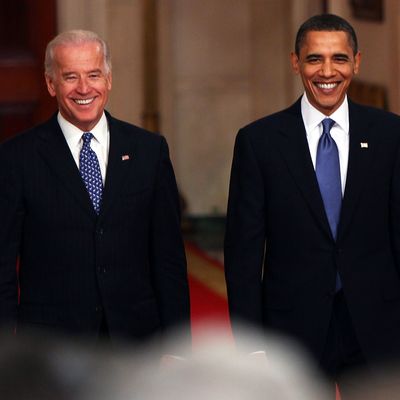
Democrats have spent the past 11 years beating back Republican efforts to dismantle, repeal, or sabotage the Affordable Care Act. Over time, the issue has transformed from a Democratic political liability to an advantage. And now that the Democrats control the federal government again, they are moving into a new stage of expanding the law.
Obamacare has two major flaws that have hampered its ability to cover the uninsured. One was created by Senate Democrats, and the other was created by Chief Justice John Roberts. The coronavirus-relief legislation begins to fix both these flaws. If it is signed into law, millions of Americans will gain access to health insurance and millions more who have insurance will pay less.
The goal of Obamacare was to create universal coverage without the politically toxic step of disrupting existing insurance arrangements. It did this through a combination of methods. The lowest-income uninsured would be covered by an expansion of Medicaid. People at a higher income level would gain access to a newly regulated and subsidized individual insurance market. Insurers would no longer be able to pick off healthy customers and deny coverage (or charge exorbitant rates) to people with preexisting conditions. Instead, the new exchanges would require insurers to sell plans regardless of health status, and people buying in would get tax credits to defray the cost.
The tax credits were too stingy, because Democrats needed 60 Senate votes to pass the law, and their most conservatives members were more concerned about holding down the law’s overall cost than optimizing coverage. The subsidy cutoff is especially harsh for middle-class people earning just over $50,000 a year.
The relief bill increases subsidies across the board. People with modest incomes, who currently pay relatively little in subsidies, would pay less or nothing. It also creates eligibility for people collecting unemployment benefits. This chart, via the Center on Budget and Policy Priorities, shows the difference for low-income people:
The most dramatic change will happen a bit higher up the income ladder. Subsidies cut off sharply around $50,000 a year. This chart shows the percentage of your income you have to pay to buy an individual plan. If you go to the site at the Kaiser Family Foundation, it adjusts by age and type of plan, but this illustrates the huge spike in costs for people earning over $51,000 a year and how the bill in Congress would ensure nobody is laying out more than 8.5 percent of their income in premiums:
The second problem is that not all states participated in the Medicaid expansion. This flaw was not in the law as written. The Supreme Court decided in 2012 to make Medicaid expansion optional (a compromise engineered by Roberts, who wanted to give conservatives something after pulling back from nearly striking down the entire law in a fit of right-wing hysteria over creeping socialism).
The Court assumed most states would participate in the Medicaid expansion, since the federal government covered 90 percent of their costs. Why wouldn’t they give their residents free medical coverage for pennies on the dollar, when the alternative was leaving them unable to work because of untreated medical conditions or showing up in emergency rooms to get coverage they couldn’t pay for? But many Republicans states refused to participate because Obamacare had become a culture-war issue in which spiting Obama became paramount and reason and self-interest no longer applied. More and more states have slowly joined in, but 14 states remain outside Medicaid, denying coverage to 4 million eligible under the law.
The new coronavirus-relief bill tries to induce those states to reconsider by increasing the generosity of the federal match. Now states taking the Medicaid expansion would have more than 100 percent of the cost covered by Washington. They would literally have to pay for the privilege of denying coverage to their poorest citizens.
And to be clear, at least some Republican states probably will happily pay for that privilege, either because they’re still mad Obama passed health-care reform or they believe denying health insurance to poor people gives them a stronger incentive to stop being poor. Eventually, Biden will have to come up with a way to cover low-income people in states led by Republicans willing to light money on fire to keep them uninsured. His public option is the main idea on the table.
Importantly, the Democratic bill only funds these coverage expansions for two years. This first law is an emergency measure designed to relieve suffering during the pandemic and the concurrent spike in unemployment.
But Biden and his allies are going to want to make these expansions permanent. Since Senate laws require that the cost of permanent increases in spending be fully offset (unless the bill can get 60 votes, which nobody expects), they’re going to have to come back and pass another law to extend the new coverage expansions permanently. That bill will probably include a public option (or, if Congress rejects it, perhaps some other mechanism to cover low-income people in states that refuse free Medicaid).
And when they set out to pass that bill, they will have an advantage Democrats have never enjoyed in the health-care wars before: The people they are trying to benefit will already have coverage. They won’t have to persuade skeptical people of the hypothetical future value of coverage they’re trying to create. They will simply be defending existing benefits, forcing any opponents to explain why they want to take coverage away.
Democrats have spent the last decade of the health-care wars trying to hold on to what Obama achieved. Now they finally have a chance to go farther.
































